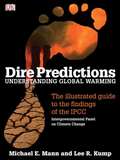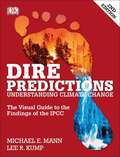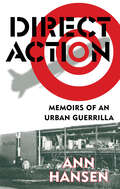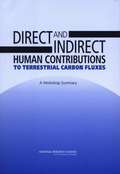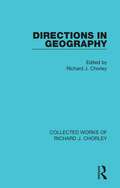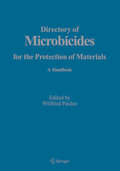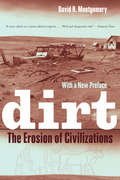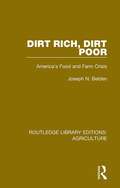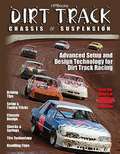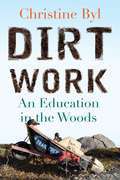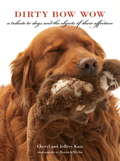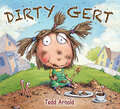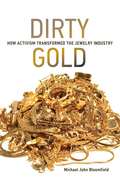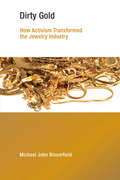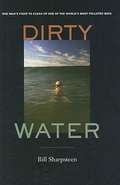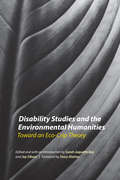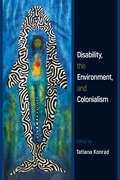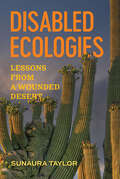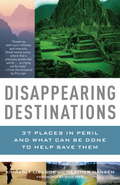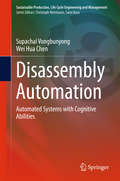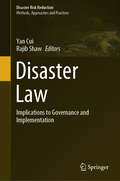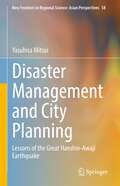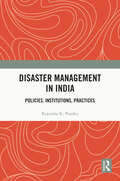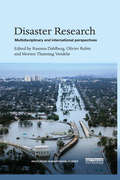- Table View
- List View
Dire Predictions
by Michael Mann Lee R. KumpInformation on global climate change drawn from the Fourth Assessment Report of the Intergovernmental Panel on Climate Change (IPCC).
Dire Predictions: Understanding Climate Change (Second Edition)
by Lee R. Kump Dorling Kindersley Publishing Staff Michael E. MannExplore global warming with graphics, illustrations, and charts that separate climate change fact from fiction, presenting the truth about global warming in a way that's both accurate and easy to understand. Respected climate scientists Michael E. Mann and Lee R. Kump address important questions about global warming and climate change, diving into the information documented by the IPCC (Intergovernmental Panel on Climate Change) and breaking it down into clear graphics that explain complex climate questions in simple illustrations that present the truth of the global warming problem clearly. These experts take scientific findings about climate change and global warming and use analogies, striking images, and understandable graphics to make the global warming question clear to both skeptics and scientists. Dire Predictions shows the evidence and the causes that respected scientists have documented in IPCC findings and climate change studies -- this powerful, illustrated book is updated with the latest IPCC information and is a must-read for anyone interested in understanding global warming and climate change and in joining the debate over the best way to combat global warming.
Direct Action: Memoirs of an Urban Guerrilla
by Ann HansenAnn Hansen stood trial as one of the so-called “Squamish Five.” Sentenced to life in prison, she served seven years. Now she tells her story for the first time. Direct Action captures the excitement and indignation of the counterculture of the early ’80s. Missile tests were fuelling a new arms race. Reckless megaprojects threatened the global environment. Alienation, punk rock, and militancy were on the rise. Hansen and her fellow urban guerrillas believed that sabotaging government and corporate property could help turn things around. To prove their point, they bombed the Litton Systems plant in Toronto, where components for Cruise Missiles were being made. Hansen’s book poses unresolved ethical dilemmas. In light of the recent explosion of anti-globalization protests, Direct Action mirrors the resurgence of militant activity around the world.
Direct and Indirect Human Contributions to Terrestrial Carbon Fluxes: A Workshop Summary
by Stephanie Johnson Rob CoppockHuman-induced climate change is an important environmental issue worldwide, as scientific studies increasingly demonstrate that human activities are changing the Earth’s climate. Even if dramatic reductions in emissions were made today, some human-induced changes are likely to persist beyond the 21st century. The Kyoto Protocol calls for emissions reporting that separates out management-induced changes in greenhouse gases from those changes caused by indirect human effects (e.g., carbon dioxide fertilization, nitrogen deposition, or precipitation changes), natural effects, and past practices on forested agricultural lands.This book summarizes a September 2003 workshop where leaders from academia, government and industry came together to discuss the current state of scientific understanding on quantifying direct human-induced change in terrestrial carbon stocks and related changes in greenhouse gas emissions and distinguishing these changes from those caused by indirect and natural effects.
Directions in Geography (Collected Works of Richard J. Chorley)
by Richard J. ChorleyOriginally published in 1973. This collection of essays looks at the ‘quantitative revolution’ and the ‘new geography’ by some of the geographers who had a significant part in those innovations and looks ahead to further developments. The views in the chapters are diverse and offer a fascinating glimpse of the discipline of geography as the subject was undergoing such change and becoming more socially committed. They cover theory, spatial-systems theory, forecasting, human ecology and climatology alongside the teaching of the subject. The concerns of the contemporary geographer come across and are of interest today as these areas have developed still more.
Directory of Microbicides for the Protection of Materials
by Wilfried PaulusThis edition is divided into two parts. Part One presents extensively diversified contributions from 23 world experts, on such topics as: Microbicides with regard to the relationship between chemical structure and mode of action and activity; Research and development in consideration of registration procedures; Legislative aspects. The use of microbicides in 18 major application areas are described in detail. Part Two collects Microbicide Data, organized into 21 substance classes (e.g. alcohols, aldehydes, acids, amides, etc.), and including some 300 entries.
Dirt
by David R. MontgomeryDirt, soil, call it what you want--it's everywhere we go. It is the root of our existence, supporting our feet, our farms, our cities. This fascinating yet disquieting book finds, however, that we are running out of dirt, and it's no laughing matter. An engaging natural and cultural history of soil that sweeps from ancient civilizations to modern times, Dirt: The Erosion of Civilizations explores the compelling idea that we are--and have long been--using up Earth's soil. Once bare of protective vegetation and exposed to wind and rain, cultivated soils erode bit by bit, slowly enough to be ignored in a single lifetime but fast enough over centuries to limit the lifespan of civilizations. A rich mix of history, archaeology and geology, Dirt traces the role of soil use and abuse in the history of Mesopotamia, Ancient Greece, the Roman Empire, China, European colonialism, Central America, and the American push westward. We see how soil has shaped us and we have shaped soil--as society after society has risen, prospered, and plowed through a natural endowment of fertile dirt. David R. Montgomery sees in the recent rise of organic and no-till farming the hope for a new agricultural revolution that might help us avoid the fate of previous civilizations.
Dirt Persuasion: Civic Environmental Populism and the Heartland's Pipeline Fight
by Derek MoscatoDirt Persuasion examines a watershed moment in U.S. environmental politics: the fight over the Keystone XL Pipeline. The complex interplay of resources extraction industries with grassroots environmentalism and advocacy has transformed the role of activists in the contemporary public sphere. Bold Nebraska&’s years-long fight against pipeline company TransCanada provides a compelling case study: a contemporary state-level organization that simultaneously challenged political and business leaders in its home state of Nebraska, at the national level in the United States, and in the foreign jurisdiction of Canada.Dirt Persuasion sheds light not only on the activism practices of social movements but also on the changing environments in which such actions are deployed. The KXL Pipeline fight represents a watershed moment both for U.S. energy politics and in the communication of environmental activism. The rural dimension of this environmental saga is critical: environmentalism must be understood from the perspective of the rural Americans who coexist with one of the planet&’s most delicate ecologies. Populism, rhetorical appeals, strategic advocacy framing, and media framing all factor prominently within the pipeline debate—leading to a civic environmental persuasion built on the attributes of narrative, engagement, hyperlocalization, and bipartisanship in order to build broad stakeholder support and influence public policy.
Dirt Rich, Dirt Poor: America's Food and Farm Crisis (Routledge Library Editions: Agriculture #9)
by Lynn Parker Alan Sanders Joseph N. Belden Vincent P. Wilber Enid Kassner Rus Sykes Ed Cooney Cynthia Schneider Marsha SimonThis book, first published in 1986, is a major reference work for the political discussions arising out of the 1985 Congress revisions of US food and farm laws. It covers production, distribution and consumption of food, analyses international as well as domestic problems, and presents new ways forward. Emphasising public policy and programmes, the book has chapters on agricultural production; environmental and resource problems; food marketing; domestic hunger and nutrition; and world hunger and development.
Dirt Track Chassis and SuspensionHP1511
by The Editor of Circle Track MagDon't just make it fast-make it state-of-the-art. Comprehensive and fully illustrated, this technical guide covers all aspects of setup and design for dirt track racing.
Dirt Work: An Education in the Woods
by Christine BylA lively and lyrical account of one woman's unlikely apprenticeship on a national-park trail crew and what she discovers about nature, gender, and the value of hard work Christine Byl first encountered the national parks the way most of us do: on vacation. But after she graduated from college, broke and ready for a new challenge, she joined a Glacier National Park trail crew as a seasonal "traildog" maintaining mountain trails for the millions of visitors Glacier draws every year. Byl first thought of the job as a paycheck, a summer diversion, a welcome break from "the real world" before going on to graduate school. She came to find out that work in the woods on a trail crew was more demanding, more rewarding--more real--than she ever imagined. During her first season, Byl embraces the backbreaking difficulty of the work, learning how to clear trees, move boulders, and build stairs in the backcountry. Her first mentors are the colorful characters with whom she works--the packers, sawyers, and traildogs from all walks of life--along with the tools in her hands: axe, shovel, chainsaw, rock bar. As she invests herself deeply in new work, the mountains, rivers, animals, and weather become teachers as well. While Byl expected that her tenure at the parks would be temporary, she ends up turning this summer gig into a decades-long job, moving from Montana to Alaska, breaking expectations--including her own--that she would follow a "professional" career path. Returning season after season, she eventually leads her own crews, mentoring other trail dogs along the way. In Dirt Work, Byl probes common assumptions about the division between mental and physical labor, "women's work" and "men's work," white collars and blue collars. The supposedly simple work of digging holes, dropping trees, and blasting snowdrifts in fact offers her an education of the hands and the head, as well as membership in an utterly unique subculture. Dirt Work is a contemplative but unsentimental look at the pleasures of labor, the challenges of apprenticeship, and the way a place becomes a home.
Dirty Bow Wow
by Jeffrey KatzA winsome collection of 50 full-color, all-breed canine portraits, each posed with a favorite play toy and accompanied by an affectionate anecdote. Dirty Wow Wow was ranked #3 on Entertainment Weekly's "Ten Things We Love" List The creators of the popular book DIRTY WOW WOW present this brand new album, featuring beloved family pets and the raggedy objects of their affection. Big dogs, small dogs, mixed breeds, purebreds, puppies, and seniors tug, chase, chew, guard, nuzzle, sleep on, and play with their shredded teddies, blankies, and chewies. Each dog portrayed has formed a bond with a self-selected favorite, and many of them remain loyal to just one toy. Among the toys that have survived the perils of puppyhood, many continue to give comfort and joy to their aging pooches. Every lovingly photographed image of our best friends with their best friends will resonate with dog lovers and the readers who love them. Reviews"Loving, whimsical tribute to dogs and their favorite chew toys. "-New York Daily News
Dirty Gert
by Tedd ArnoldGert loves dirt. She rolls in it, digs in it, even tastes it. But one day, while she's making mud pies, all that dirt changes her. Gert sprouts leaves, grows roots, and begins to photosynthesize in the sunlight! Gert is delighted, but the neighborhood can&’t believe it. . . and soon the notoriety becomes too much for the grungy, green girl. Luckily, Mom and Dad know just what to do! Told in rhythm and rhyme and full of fun, tongue-twisting vocabulary, Dirty Gert is a celebration of individuality and unconditional love. . . and, of course, of the fun of playing in the dirt. Tedd Arnold&’s cartoonish illustrations—complete with a cast of whispering worm commentators—express the joy of making mudpies, playing with worms, and most importantly, spending time with your loving family.
Dirty Gold: How Activism Transformed the Jewelry Industry
by Michael John BloomfieldGold mining can be a dirty business. It creates immense amounts of toxic materials that are difficult to dispose of. Mines are often developed without community consent, and working conditions for miners can be poor. Income from gold has funded wars. And consumers buy wedding rings and gold chains not knowing about any of this. In Dirty Gold, Michael Bloomfield shows what happened when Earthworks, a small Washington-based NGO, launched a campaign for ethically sourced gold in the consumer jewelry market, targeting Tiffany and other major firms. The unfolding of the campaign and its effect on the jewelry industry offer a lesson in the growing influence of business in global environmental politics. Earthworks planned a "shame" campaign, aimed at the companies' brands and reputations, betting that firms like Tiffany would not want to be associated with pollution, violence, and exploitation. As it happened, Tiffany contacted Earthworks before they could launch the campaign; the company was already looking for partners in finding ethically sourced gold.Bloomfield examines the responses of three companies to "No Dirty Gold" activism: Tiffany, Wal-Mart, and Brilliant Earth, a small company selling ethical jewelry. He finds they offer a case study in how firms respond to activist pressure and what happens when businesses participate in such private governance schemes as the "Golden Rules" and the "Conflict-Free Gold Standard." Taking a firm-level view, Bloomfield examines the different opportunities for and constraints on corporate political mobilization within the industry.
Dirty Gold: How Activism Transformed the Jewelry Industry (Earth System Governance)
by Michael John BloomfieldThe response from the jewelry industry to a campaign for ethically sourced gold as a case study in the power of business in global environmental politics.Gold mining can be a dirty business. It creates immense amounts of toxic materials that are difficult to dispose of. Mines are often developed without community consent, and working conditions for miners can be poor. Income from gold has funded wars. And consumers buy wedding rings and gold chains not knowing about any of this. In Dirty Gold, Michael Bloomfield shows what happened when Earthworks, a small Washington-based NGO, launched a campaign for ethically sourced gold in the consumer jewelry market, targeting Tiffany and other major firms. The unfolding of the campaign and its effect on the jewelry industry offer a lesson in the growing influence of business in global environmental politics. Earthworks planned a “shame” campaign, aimed at the companies' brands and reputations, betting that firms like Tiffany would not want to be associated with pollution, violence, and exploitation. As it happened, Tiffany contacted Earthworks before they could launch the campaign; the company was already looking for partners in finding ethically sourced gold.Bloomfield examines the responses of three companies to “No Dirty Gold” activism: Tiffany, Wal-Mart, and Brilliant Earth, a small company selling ethical jewelry. He finds they offer a case study in how firms respond to activist pressure and what happens when businesses participate in such private governance schemes as the “Golden Rules” and the “Conflict-Free Gold Standard.” Taking a firm-level view, Bloomfield examines the different opportunities for and constraints on corporate political mobilization within the industry.
Dirty Water: One Man’s Fight to Clean Up One of the World’s Most Polluted Bays
by Bill SharpsteenDirty Water is the riveting story of how Howard Bennett, a Los Angeles schoolteacher with a gift for outrageous rhetoric, fought pollution in Santa Monica Bay--and won.
Disability Studies and the Environmental Humanities: Toward an Eco-Crip Theory
by Stacy Alaimo Sarah Jaquette Ray Jay SibaraAlthough scholars in the environmental humanities have been exploring the dichotomy between “wild” and “built” environments for several years, few have focused on the field of disability studies, a discipline that enlists the contingency between environments and bodies as a foundation of its scholarship. On the other hand, scholars in disability studies have demonstrated the ways in which the built environment privileges some bodies and minds over others, yet they have rarely examined the ways in which toxic environments engender chronic illness and disability or how environmental illnesses disrupt dominant paradigms for scrutinizing “disability.” Designed as a reader for undergraduate and graduate courses, Disability Studies and the Environmental Humanities employs interdisciplinary perspectives to examine such issues as slow violence, imperialism, race, toxicity, eco-sickness, the body in environmental justice, ableism, and other topics. With a historical scope spanning the seventeenth century to the present, this collection not only presents the foundational documents informing this intersection of fields but also showcases the most current work, making it an indispensable reference.
Disability, the Environment, and Colonialism
by Tatiana KonradDrawing on contemporary and historic literary and media examples of Western colonialism and Anglophone writings, Disability, the Environment, and Colonialism traces how the perverse nature of colonialism continues to dominate the globe today. The editor and contributors provide a careful analysis of the intersection of disability, the environment, and colonialism to understand issues such as eco-ableism, environmental degradation, homogenized approaches to environmentalism, and climate change. They also look at the body as a site of colonial oppression and environmental exploitation. Contributors: Holly Caldwell, Matthew J. C. Cella, John Gulledge, Memona Hossain, Nancy J. Hirschmann, Iain Hutchison, Andrew B. Jenks, Suha Kudsieh, Gordon M. Sayre, Jessica A. Schwartz, Anna Stenning, Aubrey Tang, Alice Wexler, and the editor.
Disabled Ecologies: Lessons from a Wounded Desert
by Sunaura Taylor"With breath-catching insight and enveloping compassion, Sunaura Taylor shares a secret of epochal urgency: people living with injury and impairment have much to teach about how to survive, and perhaps even thrive, on an injured and impaired planet."—Naomi Klein, author of Doppelganger A powerful analysis and call to action that reveals disability as one of the defining features of environmental devastation and resistance. Deep below the ground in Tucson, Arizona, lies an aquifer forever altered by the detritus of a postwar Superfund site. Disabled Ecologies tells the story of this contamination and its ripple effects through the largely Mexican American community living above. Drawing on her own complex relationship to this long-ago injured landscape, Sunaura Taylor takes us with her to follow the site's disabled ecology—the networks of disability, both human and wild, that are created when ecosystems are corrupted and profoundly altered. What Taylor finds is a story of entanglements that reach far beyond the Sonoran Desert. These stories tell of debilitating and sometimes life-ending injuries, but they also map out alternative modes of connection, solidarity, and resistance—an environmentalism of the injured. An original and deeply personal reflection on what disability means in an era of increasing multispecies disablement, Disabled Ecologies is a powerful call to reflect on the kinds of care, treatment, and assistance this age of disability requires.
Disappearing Destinations
by Kimberly Lisagor Heather HansenA beautiful and memorable look at some of the most gorgeous endangered places on the planet. Machu Picchu is a mesmerizing, ancient Incan city tucked away in the mountains of Peru, but it is rapidly being worn down by the thousands of feet treading across its stones. Glacier National Park is a destination long known for the stunning beauty of its ice floes, but in our lifetimes it will have no glaciers due to global warming. In the biobays of Puerto Rico swimmers can float in a sea shimmering with bioluminescent life, but sediment being churned up by development is killing the dinoflagellates that produce the eerie and beautiful glow. And in the Congo Basin of Africa, where great apes roam freely in lush, verdant rainforests, logging is quickly destroying the vast life-giving canopies. These places-along with many others across the globe-are changing as we speak due to global warming, environmental degradation, overuse, and natural causes. From the Boreal Forests in Finland to the Yangtze River Valley in China,37 Places to See Before They Disappearis a treasure trove of geographic wonder, and a guide to these threatened destinations and what is being done to save them.
Disassembly Automation
by Supachai Vongbunyong Wei Hua ChenThis book presents a number of aspects to be considered in the development of disassembly automation, including the mechanical system, vision system and intelligent planner. The implementation of cognitive robotics increases the flexibility and degree of autonomy of the disassembly system. Disassembly, as a step in the treatment of end-of-life products, can allow the recovery of embodied value left within disposed products, as well as the appropriate separation of potentially-hazardous components. In the end-of-life treatment industry, disassembly has largely been limited to manual labor, which is expensive in developed countries. Automation is one possible solution for economic feasibility. The target audience primarily comprises researchers and experts in the field, but the book may also be beneficial for graduate students.
Disaster Law: Implications to Governance and Implementation (Disaster Risk Reduction)
by Yan Cui Rajib ShawThis book covers the broad aspects of disaster legislation, governance, and their implementation. The book also includes in-depth reviews and new data, based on case studies across the globe, involving multidisciplinary research. In addition, the book suggests specific policies and action measures to enhance the implementation of disaster legislation for the resilience of people and local governments. Disaster law is the core to disaster risk management. The legal framework not only provides the government an instrument to take actions before, during, and after a disaster, but it also helps in recovery process. The legislative measures provide certain levels of guidance to different stakeholders such as national governments, local governments, civil societies, and more importantly citizens. The legal provision gives people and communities certain obligations as well as responsibilities to act during or before disasters. Over the last several years, there has been new disaster laws formulated in many countries, and revisions have been made to adjust the existing disaster laws to be more effective. Although it is important to have governance provision of disaster law, its implementation is essential.
Disaster Management and City Planning: Lessons of the Great Hanshin-Awaji Earthquake (New Frontiers in Regional Science: Asian Perspectives #58)
by Yasuhisa MitsuiThis book first provides a comprehensive guideline for future disaster-resistant city planning in large cities in disaster-prone countries such as Japan. It is a compilation of knowledge and know-how obtained through the author’s work in the national government for one and half years in the Earthquake Reconstruction Headquarters, right after the Great Hanshin-Awaji Earthquake on 17 January 1995. The author has carefully examined the various ad hoc measures taken just after the earthquake, which were criticized because they did not work as well as expected. Additionally, he has examined the later revisions in disaster and risk management systems made at the levels of local and national governments through experience in the Hanshin-Awaji Earthquake, to which the author had long been committed. The author argues that the rescue activities, rehabilitation, and reconstruction plans for disaster countermeasures implemented once a disaster has occurred and the city planning established in ordinary times should be extremely tightly connected with each other. City planning that subsumes rescue activities, rehabilitation, and reconstruction plans against what ought to have happened would critically improve the capability of crisis management and, consequently, protect life and property once a disaster has occurred. Such city planning eventually creates disaster-resistant cities. This book assumes readers to be graduate students who study city planning. It is also beneficial for practitioners and policy makers who are in charge of the construction of disaster-resistant cities at the national and local levels of governments, especially in disaster-prone countries.
Disaster Management in India: Policies, Institutions, Practices
by Rajendra K. PandeyThis book explores policies, structures, and processes of disaster management in India examining key theoretical foundations of disaster management with practical illustrations and case studies. The book offers a comprehensive understanding of disaster management policies and practices in India and focuses on public policy approaches in addressing critical issues and challenges facing the machinery and processes of disaster management in India. The creative approach to deal with different aspects of disaster management has helped in holistic delineation of a number of critical themes such as legal frameworks of disaster management, good practices, use of innovative approaches and technology, multilateral cooperation, the role of civil society organisations, among others. This book will be of interest to the students and researchers working in the field of disaster studies, geography, geology, development studies, public administration, public policy, economics, and governance. It will also be an invaluable companion for policy makers, practitioners, academicians and development planners working in the area of disaster management.
Disaster Research: Multidisciplinary and International Perspectives (Routledge Humanitarian Studies)
by Olivier Rubin Rasmus Dahlberg Morten Thanning VendeløGiven the tendency of books on disasters to predominantly focus on strong geophysical or descriptive perspectives and in-depth accounts of particular catastrophes, Disaster Research provides a much-needed multidisciplinary perspective of the area. This book is is structured thematically around key approaches to disaster research from a range of different, but often complementary academic disciplines. Each chapter presents distinct approaches to disaster research that is anchored in a particular discipline; ranging from the law of disasters and disaster historiography to disaster politics and anthropology of disaster. The methodological and theoretical contributions underlining a specific approach to disasters are discussed and illustrative empirical cases are examined that support and further inform the proposed approach to disaster research. The book thus provides unique insights into fourteen state-of-the-art disciplinary approaches to the understanding of disasters. The theoretical discussions as well as the diverse range of disaster cases should be of interest to both postgraduate and undergraduate students, as well as academics, researchers and policymakers.
